
Dragon Quest VII: Fragments of the Forgotten Past is a 2000 Japanese role-playing video game developed by Heartbeat and ArtePiazza, and published by Enix for the PlayStation. It was released in North America in 2001 under the title Dragon Warrior VII. The game received a remake on the Nintendo 3DS in Japan in 2013, released in English under the title Dragon Quest VII: Fragments of the Forgotten Past in 2016. A version of the game for Android and iOS was released in Japan in 2015.

Dragon Quest II: Luminaries of the Legendary Line, titled Dragon Warrior II when initially localized to North America, is a role-playing video game developed by Chunsoft and published by Enix in 1987 for the Nintendo Entertainment System as a part of the Dragon Quest series. Enix's U.S. subsidiary published the American release, Dragon Warrior II, for the Nintendo Entertainment System in 1990. Dragon Quest II is set one hundred years after the events of the first game.

Dragon Quest IV: Chapters of the Chosen, titled Dragon Warrior IV when initially localized to North America, is a role-playing video game, the fourth installment of the Dragon Quest video game series developed by Chunsoft and published by Enix, and the first of the Zenithian Trilogy. It was originally released for the Famicom on 11 February 1990 in Japan. A North American NES version followed in October 1992, and would be the last Dragon Quest game localized and published by Enix's Enix America Corporation subsidiary prior to its closure in November 1995, as well as the last Dragon Quest game to be localized into English prior to the localization of Dragon Warrior Monsters in December 1999. The game was remade by Heartbeat for the PlayStation, which eventually was available as an Ultimate Hits game. The remake was ported by ArtePiazza to the Nintendo DS, released in Japan November 2007 and worldwide in September 2008. A mobile version based on the Nintendo DS remake was released in 2014 for Android and iOS.
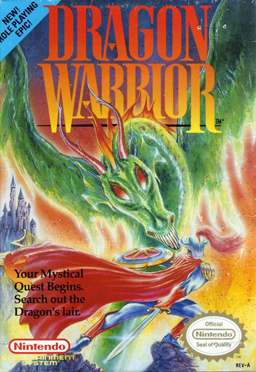
Dragon Quest, titled Dragon Warrior when initially localized to North America, is a role-playing video game developed by Chunsoft and published by Enix for the Nintendo Entertainment System. It was originally released in Japan in 1986 and by Nintendo in North America in 1989. It is the first game in the Dragon Quest video game series. Dragon Quest has been ported and remade for several video game platforms, including the MSX, MSX2, PC-9801, Super Famicom, Game Boy Color, mobile phones, and Nintendo Switch as of 2019. The player controls the hero character who is charged with saving the Kingdom of Alefgard and rescuing its princess from the evil Dragonlord. Dragon Warrior's story became the second part in a trilogy, with several spinoff anime and manga series.

Torneko: The Last Hope is a 1999 role-playing video game for the PlayStation. The game was co-developed by Chunsoft and Matrix Software and published by Enix. In Japan, the game was ported to the Game Boy Advance in 2001.
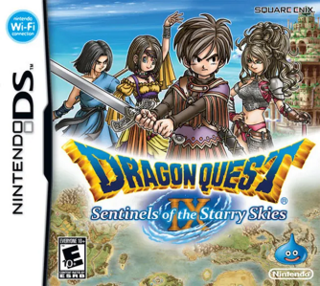
Dragon Quest IX: Sentinels of the Starry Skies is a role-playing video game co-developed by Level-5 and Square Enix for the Nintendo DS. Published by Square Enix in Japan in 2009, and by Nintendo overseas in 2010, it is the ninth mainline entry in the Dragon Quest series. The storyline follows the protagonist, a member of the angelic Celestrian race, after a disaster in their home scatters magical fruits across the mortal realm. While carrying over traditional gameplay from the rest of the series with turn-based battles, the game is the first Dragon Quest entry to feature a customizable player character, and the first to include a multiplayer mode, with the option of trading treasure maps and loaning player characters through Nintendo Wi-Fi. Online functions ended in 2014 when it ceased operations.

Shoko Nakagawa is a Japanese media personality, singer, actress, voice actress, illustrator, and YouTuber. Also known by her nickname Shokotan (しょこたん), she is best known as the presenter of Pokémon Sunday, and as the performer of the opening theme from the anime Gurren Lagann.
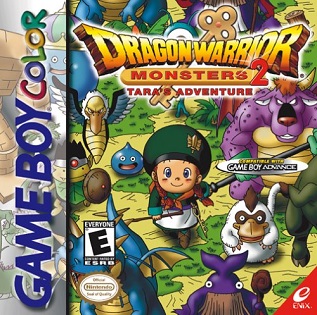
Dragon Warrior Monsters 2, known in Japan as Dragon Quest Monsters 2, is a role-playing video game published by Enix for the Game Boy Color. It is the second Dragon Warrior Monsters game for the Game Boy Color and features two different versions of the same game, Cobi's Journey and Tara's Adventure. Both games were remade in 2002 for the PlayStation in a compilation game called Dragon Quest Monsters 1+2 and released only in Japan. The Nintendo 3DS version combined both games into one and was released only in Japan in 2014 with the title Dragon Quest Monsters 2: Iru and Luca's Marvelous Mysterious Key. The 3DS version was later brought to iOS, Android on August 6, 2020, in Japan.

Dragon Quest Characters: Torneko's Great Adventure 3 – Mystery Dungeon is the third game in the Torneko series. It is part of the Mystery Dungeon series and contains randomly generated dungeons and uses turn-based action combat. It is the third Dragon Quest spin-off game in Mystery Dungeon. The game was also made for the Game Boy Advance in 2004 as Torneko's Great Adventure 3 Advance.

Dragon Quest X: Rise of the Five Tribes Online, also known as Dragon Quest X Online, is a massively multiplayer online role-playing game (MMORPG) developed and published by Square Enix. It is the tenth mainline entry in the Dragon Quest series. It was originally released for the Wii in 2012, and was later ported to the Wii U, Windows, PlayStation 4, Nintendo Switch, Android, iOS, and Nintendo 3DS, all of which support cross-platform play. Other than a discontinued Windows version in China, the game was not released outside of Japan. A single-player remake, titled Dragon Quest X Offline, was released in 2022 in Japan. It is also set to release in other Asian regions in 2024.

Dragon Quest Heroes: The World Tree's Woe and the Blight Below is a hack and slash game developed by Omega Force and published by Square Enix. It was released for PlayStation 3 and PlayStation 4 in Japan in February 2015, and in North America, Australia and Europe only for PlayStation 4 in October 2015. It was later released for Microsoft Windows in December 2015. The game received generally positive reviews, with a sequel Dragon Quest Heroes II being released in Japan during May 2016. Dragon Quest Heroes would later be released with the sequel in a compilation for Nintendo Switch in Japan.
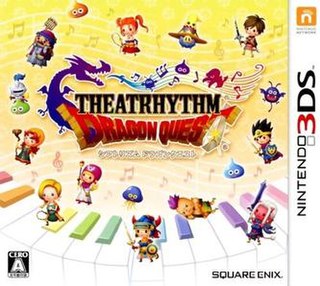
Theatrhythm Dragon Quest is a rhythm game developed by indieszero and published by Square Enix for the Nintendo 3DS. It was released in Japan on March 26, 2015, and was the first game of its type in the Dragon Quest series and the third Theatrhythm game after Theatrhythm Final Fantasy and Theatrhythm Final Fantasy: Curtain Call.
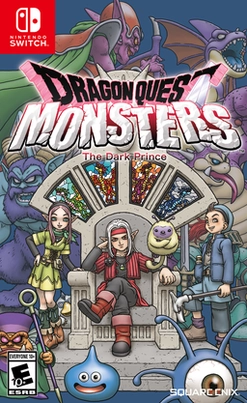
Dragon Quest Monsters: The Dark Prince is a 2023 role-playing video game developed by Tose and published by Square Enix for the Nintendo Switch. It is the seventh game in the Dragon Quest Monsters series following Dragon Quest Monsters: Joker 3 and the first to be released outside of Japan since Joker 2 in 2011. The game received mixed reviews from critics and sold a million copies by January 2024. It is the last Dragon Quest game to be released during Akira Toriyama's lifetime.

Psaro is a character in the 1990 video game Dragon Quest IV. He is the primary antagonist of the story, leading a charge to wipe out humanity for the sake of demons, particularly due to his infatuation for an elf named Rose, who suffered under humans. He wishes to find and kill the human prophesized to one day defeat him, which causes him or his minions to come into contact with one or more of the multiple main heroes of the game who later come to support the prophesized hero in their quest.
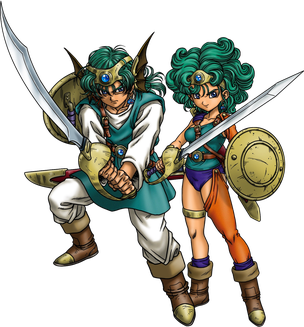
The Hero is the protagonist of Dragon Quest IV, and can be male or female. They do not have a default name, and can be given a name by the player. They are the second Hero in Dragon Quest to allow players to make them male or female, and the first to give the female Hero a distinct design. During the course of the story, the game's antagonist, Psaro, causes the death of their village, including their friend Eliza. They journey to defeat Psaro, joining other characters along the way. Their design was created by Akira Toriyama. There was originally meant to be more differences between the male and female Hero, but the game's designer, Yuji Horii, remembered to do this too late in development to implement this. The Hero has been the subject of discussion by critics, both for their tragic story and the female Hero. Multiple critics appreciated the existence of the female Hero, particularly due to being able to play as a woman in a role-playing game, which was not as common at the time.
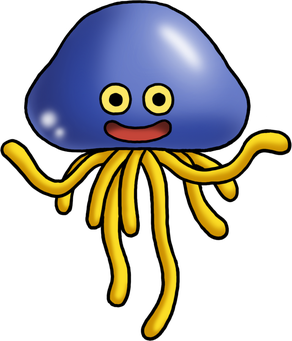
Healie is a character in the 1990 video game Dragon Quest IV. He is a Cureslime who aspires to become a human, joining the warrior Ragnar McRyan in his quest to rescue kidnapped children from minions of Psaro. He is a Cureslime, a variant of the Slime monster from the series. He was created by Yuji Horii and designed by Akira Toriyama. Due to his popularity with fans, Horii elected to expand upon the idea of having monsters as companion, adding it as a game mechanic to the sequel, Dragon Quest V. He has since appeared in other Dragon Quest games, including Dragon Quest Monsters: The Dark Prince, where he is seen in a human form. He has been among the more popular companions in the series, praised by critics for being cute and a reliable partner to Ragnar.
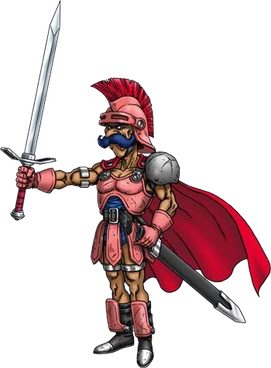
Ragnar McRyan is a character in the 1990 video game Dragon Quest IV. He is one of multiple characters who assist the game's Hero in their battle against the monster Psaro. He is the first playable character, and allies with the monster Healie, who aspires to become human, to rescue children kidnapped by Psaro's minions. He is created by Yuji Horii and designed by Akira Toriyama, and has a Scottish accent in the English version of the Nintendo DS remake. He has received generally positive reception, with critics noting how he represented an old-fashioned, uncomplicated type of hero that they felt is absent in newer games.

Maya and Meena are two characters in the 1990 video game Dragon Quest IV. Maya is a dancer and Meena a fortune teller, and they are both on a journey to discover the truth of their father's murder. They appear as the lead characters of the fourth chapter, and join the Hero in the fifth chapter to defeat the monster Psaro. They were created by Yuji Horii and designed by Akira Toriyama, and have been the subject of praise for both their designs and concepts, particularly Meena's use of tarot cards as weapons and Maya's beauty. Their theme has also received praise, with critics identifying folk music and Middle Eastern music inspirations.


















